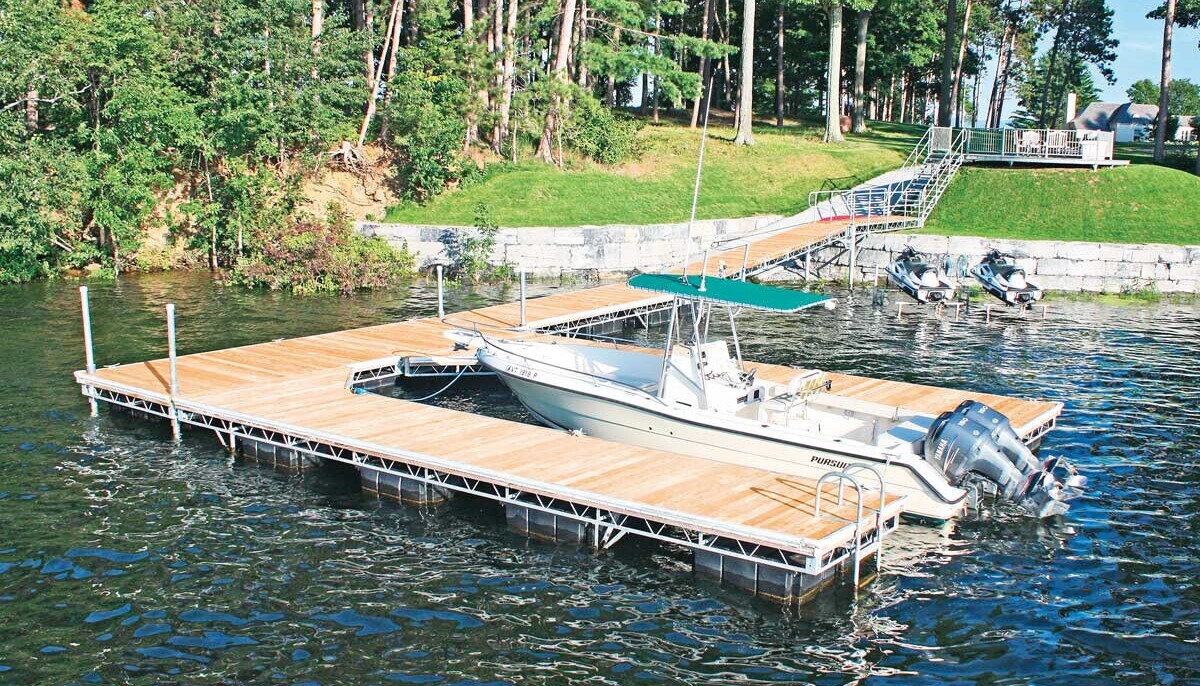Crafting Custom Solutions: Why a Floating Dock Builder is Vital for Distinct Requirements
Upgrade Your Beachfront With Long Lasting Floating Docks
Upgrading your beachfront with durable floating docks can dramatically improve both capability and aesthetic appeals, giving a versatile option for various water activities. With an array of products offered, consisting of low-maintenance options and conventional timber, picking the best dock can match your individual design and fulfill practical needs.
Benefits of Floating Docks
Floating docks deal a plethora of benefits that improve their appeal for numerous maritime applications. Unlike standard fixed docks, floating docks increase and fall with the tide, making sure constant accessibility for watercrafts and watercraft no matter of environmental problems.
Furthermore, floating docks are less complicated to move and install, supplying flexibility for seasonal or short-lived use. Their modular style permits for customization to fit specific requirements, whether for private marinas, property beachfronts, or industrial applications.
Furthermore, floating docks create minimal disturbance to the marine setting, preserving regional ecological communities and decreasing the probability of disintegration. They also offer improved safety and security and security for users, as their buoyant nature uses an extra flexible surface area than rigid structures.
Additionally, floating docks can assist in a varied series of activities, such as fishing, swimming, and leisure boating, making them a useful property for beachfront development. Their flexibility and functionality make floating docks a recommended choice for a variety of marine tasks.
Picking the Right Products
Picking ideal materials for floating docks is important to their longevity, performance, and general efficiency. When selecting products, take into consideration elements such as ecological direct exposure, maintenance demands, and architectural honesty. Usual products consist of timber, plastic, light weight aluminum, and composite alternatives, each offering distinctive benefits and drawbacks.
Timber, while visually pleasing, calls for routine upkeep to avoid rot and degeneration. Pressure-treated wood can improve toughness, however it might still surrender to water damages with time. Plastic drifts, frequently made from high-density polyethylene, are resistant to deterioration and call for very little upkeep, making them an appealing choice for low-maintenance applications.
Light weight aluminum is one more viable alternative, understood for its strength and light-weight properties. It is immune to rust and can hold up against extreme climate condition, although it may be more pricey than other products. Composite products combine the ideal attributes of wood and plastic, using a low-maintenance and resilient choice that mimics the look of wood without the linked drawbacks.
Inevitably, the option of material must align with the intended usage, ecological considerations, and budget plan restrictions, guaranteeing a useful and sturdy floating dock that satisfies your particular demands.
Setup Process Overview
The effective installation of a floating dock relies upon mindful preparation and execution, guaranteeing that it operates efficiently in its intended atmosphere. The initial step entails examining website conditions, including water depth, coastline attributes, and prevailing weather patterns, which will notify the dock layout and anchoring system.
Following the site evaluation, the next stage is to prepare the floating dock parts. This consists of setting up the framework, safeguarding drifts, and affixing any required hardware. It is critical to ensure that all connections are water-resistant and robust to endure marine conditions.
When the dock is set up, the installment procedure starts with placing the dock in the water. This can entail a crane or various other training tools, specifically for bigger frameworks. Correct placement is crucial for capability and safety and security.

Upkeep Tips for Longevity
Routine maintenance is necessary for guaranteeing the long life and optimal efficiency of a floating dock. To accomplish this, start with routine examinations at the very least two times a year, focusing on the stability of the dock's framework, including the flotation protection devices and linking equipment. Search for indicators of rust, damages, or wear, and deal with any type of issues immediately to prevent additional deterioration.
Cleaning up is an additional vital facet of upkeep. Eliminate particles, algae, and barnacles from the dock's surface area to prevent slippery problems and preserve visual allure. Use a mild detergent and a soft brush to stay clear of harming the dock's products.
Additionally, guarantee that the dock is correctly anchored and protected to linked here stand up to seasonal adjustments in water levels and climate condition. Examine the anchoring system for security and make changes as required.
Enhancing Your Outdoor Visual
To produce an aesthetically enticing exterior room, including a drifting dock can significantly enhance the overall visual of your beachfront home. Floating docks are not only useful yet can additionally act as a striking focal factor that matches the natural surroundings - dock company. Readily available in numerous materials and styles, these docks can be personalized to match your residential property's architectural design and landscape
The addition of decorative elements, such as incorporated illumination or trendy railings, better raises the dock's visual allure. Take into consideration utilizing natural timber surfaces, which blend flawlessly with the atmosphere, or selecting modern-day materials like light weight aluminum or composite outdoor decking that provide a streamlined, modern look.
Purposefully putting planters or seating locations on or around the dock can produce inviting rooms that encourage leisure and pleasure of beachfront views. Additionally, including colors and appearances that harmonize with your landscape will certainly produce a cohesive visual throughout your outdoor location.

Conclusion

Updating your waterfront with sturdy floating docks can dramatically enhance both capability and appearances, offering a functional solution for different water tasks. Unlike standard set docks, floating docks rise and autumn with the trend, making sure regular ease of access for watercrafts and boat regardless of environmental problems.Picking suitable products for floating docks is essential to their durability, efficiency, and overall performance.As soon as the dock i loved this is set up, the installment process begins with placing the dock in the water.In summary, floating docks offer countless advantages, including adaptability to water degree modifications and a selection of product alternatives.